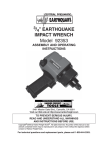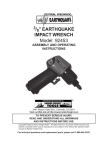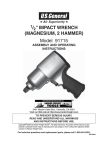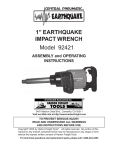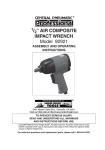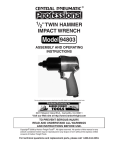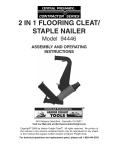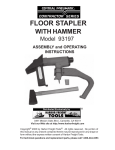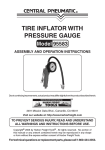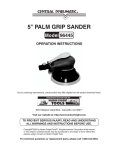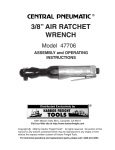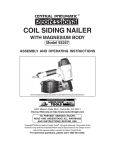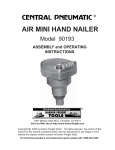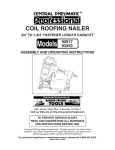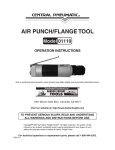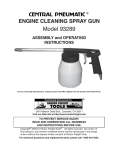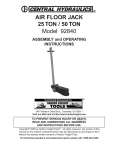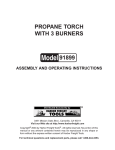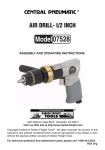Download Harbor Freight Tools 92427 User's Manual
Transcript
® 1” AIR IMPACT WRENCH Model 92427 ASSEMBLY and OPERATING INSTRUCTIONS ® 3491 Mission Oaks Blvd., Camarillo, CA 93011 Visit our Web site at http://www.harborfreight.com TO PREVENT SERIOUS INJURY, READ AND UNDERSTAND ALL WARNINGS AND INSTRUCTIONS BEFORE USE. Copyright © 2004 by Harbor Freight Tools® . All rights reserved. No portion of this manual or any artwork contained herein may be reproduced in any shape or form without the express written consent of Harbor Freight Tools. For technical questions and replacement parts, please call 1-800-444-3353 Specifications Maximum Torque Drive Size Air Inlet Recommended Air Pressure Maximum Air Pressure Blows Per Minute Air Consumption Tool Weight Impact Mechanism 1450 Ft. Lbs. 1” 1/2” - 14 NPT 90 PSI 120 PSI 800 12 CFM 27.7 Lbs. Twin Hammer Save This Manual You will need the manual for the safety warnings and precautions, assembly instructions, operating and maintenance procedures, parts list and diagram. Keep your invoice with this manual. Write the invoice number on the inside of the front cover. Keep the manual and invoice in a safe and dry place for future reference. Safety Warnings and Precautions WARNING: When using tool, basic safety precautions should always be followed to reduce the risk of personal injury and damage to equipment. Read all instructions before using this tool! 1. Keep work area clean. Cluttered areas invite injuries. 2. Observe work area conditions. Do not use machines or power tools in damp or wet locations. Don’t expose to rain. Keep work area well lighted. Do not use electrically powered tools in the presence of flammable gases or liquids. 3. Keep children away. Children must never be allowed in the work area. Do not let them handle machines, tools, extension cords, or air hoses. 4. Store idle equipment. When not in use, tools must be stored in a dry location to inhibit rust. Always lock up tools and keep out of reach of children. 5. Use the right tool for the job. Do not attempt to force a small tool or attachment to do the work of a larger industrial tool. There are certain applications for which this tool was designed. It will do the job better and more safely at the rate for which it was intended. Do not modify this tool and do not use this tool for a purpose for which it was not intended. 6. Dress properly. Do not wear loose clothing or jewelry as they can be caught in moving parts. Protective, electrically nonconductive clothes and nonskid footwear are recommended when working. Wear restrictive hair covering to contain long hair. SKU 92427 For technical questions, please call 1-800-444-3353 Page 2 7. Use eye and ear protection. Always wear ANSI approved impact safety goggles. Wear a full face shield if you are producing metal filings or wood chips. Wear an ANSI approved dust mask or respirator when working around metal, wood, and chemical dusts and mists. 8. Do not overreach. Keep proper footing and balance at all times. Do not reach over or across running machines or air hoses. 9. Maintain tools with care. Keep tools clean for better and safer performance. Follow instructions for lubricating and changing accessories. Inspect tool cords and air hoses periodically and, if damaged, have them repaired by an authorized technician. The handles must be kept clean, dry, and free from oil and grease at all times. 10. Disconnect air supply. Disconnect air hose when not in use. 11. Remove adjusting keys and wrenches. Check that keys and adjusting wrenches are removed from the tool or machine work surface before plugging it in. 12. Avoid unintentional starting. Be sure the switch is in the Off position when not in use and before plugging in. Do not carry any tool with your finger on the trigger, whether it is plugged in or not. 13. Stay alert. Watch what you are doing, use common sense. Do not operate any tool when you are tired. 14. Check for damaged parts. Before using any tool, any part that appears damaged should be carefully checked to determine that it will operate properly and perform its intended function. Check for alignment and binding of moving parts; any broken parts or mounting fixtures; and any other condition that may affect proper operation. Any part that is damaged should be properly repaired or replaced by a qualified technician. Do not use the tool if any switch does not turn On and Off properly. 15. Guard against electric shock. Prevent body contact with grounded surfaces such as pipes, radiators, ranges, and refrigerator enclosures. 16. Replacement parts and accessories. When servicing, use only identical replacement parts. Use of any other parts will void the warranty. Only use accessories intended for use with this tool. Approved accessories are available from Harbor Freight Tools. 17. Do not operate tool if under the influence of alcohol or drugs. Read warning labels if taking prescription medicine to determine if your judgement or reflexes are impaired while taking drugs. If there is any doubt, do not operate the tool. 18. Use proper size and type extension cord. If an extension cord is required, it must be of the proper size and type to supply the correct current to the compressor without heating up. Otherwise, the extension cord could melt and catch fire, or cause electrical damage to the tool. Check your air compressor’s manual for the appropriate size cord. 19. Maintenance. For your safety, maintenance should be performed regularly by a qualified technician. 20. Compressed air only. Never use combustible gas as a power source. SKU 92427 For technical questions, please call 1-800-444-3353 Page 3 21. This Impact Wrench should only be used with impact sockets and extensions. Using any other accessories can cause the accessories to break, causing permanent damage to the unit and severe injury to the operator. Note: Performance of the compressor (if powered by line voltage) may vary depending on variations in local line voltage. Extension cord usage may also affect tool performance. Warning: The warnings, cautions, and instructions discussed in this instruction manual cannot cover all possible conditions and situations that may occur. It must be understood by the operator that common sense and caution are factors which cannot be built into this product, but must be supplied by the operator. Unpacking When unpacking, check to make sure the parts listed on page 8 are included. If any parts are missing or broken, please call Harbor Freight Tools at the number on the cover of this manual as soon as possible. Air Connection Impact Wrench For best service you should incorporate an oiler, regulator, and inline filter, as shown in the diagram above. Hoses, couplers, oilers, regulators, and filters are all available at Harbor Freight Tools. 1. You will need to prepare a 1/2” air connector (not included) to connect to the Air Inlet (23) on the Impact Wrench. First, wrap the 1/2” air connector with pipe thread seal tape before threading it into the Air Inlet (23). Connect the 3/8” ID air source hose to a quick connect coupler, and then to the Impact Wrench. Note: If you are not using an automatic oiler system, before operation, add a few drops of Pneumatic Tool Oil to the airline connection. Add a few drops more after each hour of continual use. 2. Set the air pressure on the regulator. Note: To achieve the maximum torque of 1450 Ft. Lbs., set the air pressure at 120 PSI. Never exceed 120 PSI. 3. Check the air connection for leaks. Disconnect from the air source. SKU 92427 For technical questions, please call 1-800-444-3353 Page 4 Assembly 1. Place the Handle (48) into the handle slot and secure it with two Screws (49). See FIGURE 1. Securing with the two Screws (49) FIGURE 1 Operation Warning!! This Impact Wrench supplies powerful torque and is designed to be operated with two hands. Failure to operate the Impact Wrench with two hands may result in serious, permanent injury. See FIGURE 3 below. Handle (48) FIGURE 2 Trigger (21) Anvil (43) Wrench (54) Air Coupler Air Inlet (23) Forward/Reverse Valve (34) FIGURE 3 Proper way to hold the Impact Wrench SKU 92427 For technical questions, please call 1-800-444-3353 Page 5 Operation (continued) Refer to FIGURES 2 and 4, and the Assembly Drawing on page 9. Note: Turn off your air compressor and disconnect the air hose when you are changing sockets. After you attach the socket, attach the air hose and turn the air compressor on. 1. Select the appropriate size 1” drive socket for your needs. 2. Push and snap the socket (not included) onto the Anvil (43). 3. To operate the Forward/Reverse Valve (34) follow the directions in FIGURE 5 below. FIGURE 4 Oil Screw (22) Forward (tightening) FIGURE 5 Note: On the bottom of the Forward/Reverse Valve (34) there are markings on the valve that show what direction the Forward/Reverse Valve (34) is set to. If the bottom valve is turned in the “Off” arrow’s direction, then the Impact Wrench is set to take off bolts. If the bottom valve is turned in the “On” arrow’s direction, then the Forward/ Reverse Valve (34) is set to tighten on bolts. Reverse (loosening) ON OFF Tightening Note: Set the Forward/Reverse Valve (34) so that the anvil turns clockwise (forward). 4. Tighten the nut as tight as you can by hand. 5. Place the socket (not included) over the nut you wish to tighten. 6. Grip the Impact Wrench firmly with two hands and gently squeeze the Trigger (21). Note: If the Impact Wrench cannot tighten the nut to your satisfaction, do not raise the air pressure on the compressor over 120 PSI. Pressures above 120 PSI will strip the workpiece and damage the tool, potentially causing the tool to fail, causing serious injury. Use other appropriate methods and tools to tighten the nut. 7. When the nut is tightened, release the Trigger (21). Turn off the air compressor and disconnect the hose. 8. Always check the recommended torque specification for the nut. Use a torque wrench to tighten the nut to the proper setting after using the Impact Wrench. SKU 92427 For technical questions, please call 1-800-444-3353 REV 11/04 Page 6 Operation (continued) Loosening Note: Set the Forward/Reverse Valve (34) so that the anvil turns counterclockwise (reverse). 9. Place the socket (not included) over the nut you wish to loosen. 10. Grip the Impact Wrench firmly with two hands and gently squeeze the Trigger (21). Note: If the Impact Wrench cannot loosen the nut, do not raise the air pressure on the compressor over 120 PSI. Do not attempt to loosen the nut with the Impact Wrench. Use other appropriate methods and tools to loosen the nut. 11. When the nut is loosened, release the Trigger (21). Turn off the air compressor and disconnect the hose. 12. If needed, remove the nut from the socket. Maintenance 1. Make sure your Impact Wrench is disconnected from the air hose before attempting any maintenance. 2. Wipe the Impact Wrench down with a lint free cloth after each use. 3. Make sure the Anvil (43) is clear of dirt or debris. If possible, spray it with compressed air before each use. 4. If you do not use an inline oiler/filter system, lubricate the tool daily by holding it so that the Air Inlet (23) is facing up. Squeeze the Trigger (21), and place one or two drops of oil into the Air Inlet (23). Squeezing the Trigger (21) allows the oil to circulate in the motor. 5. Periodically, add a high quality machine oil to the oil inlet by removing the Oil Screw (22). See FIGURE 6 below. 6. Repairs should only be done by a qualified service technician. FIGURE 6 Remove the Oil Screw (22) with the Wrench (54). Fill with a high quality machine oil. Replace the Oil Screw (22). Note: A second oil plug, not shown here, is located at the front end of housing. SKU 92427 Oil Screw (22) For technical questions, please call 1-800-444-3353 Page 7 Parts List Part No. 1 2 3 4 5 6 7 8 9 10 11 12 13 14 15 16 17 18 19 20 21 22 23 24 25 26 27 Description Bumper Spacer 0-ring Screw Nut Motor Housing Bearing Roll Pin Rear End Plate Cylinder Rotor Blade Roll Pin Front End Plate Handle Gasket Lock Washer Pistol Grip Handle Screw Roll Pin Roll Pin Trigger Oil Screw Air Inlet Air Filter Throttle Valve Bushing Valve Spring 0-ring Qty. 1 1 1 4 4 1 2 2 1 1 1 6 1 1 1 4 1 4 1 1 1 2 1 1 1 1 1 Part No. 28 29 30 31 32 33 34 35 36 37 38 39 40 41 42 43 44 45 46 47 48 49 50 51 52 53 54 Description Valve Spring 0-ring Screw Spring Bearing Roll Pin Forward/Reverse Valve 0-ring Roll Pin Reverse Valve Valve Bushing Roll Pin Impact Ring Impact Cage Impact Pin Anvil Front Shaft Bushing Front Spacer 0-ring Spring Ring Handle Screw Handrail Screw Clutch Housing B-ring Wrench Qty. 1 1 1 1 1 1 1 1 1 1 1 1 2 1 2 1 1 1 1 1 1 2 1 2 1 1 1 PLEASE READ THE FOLLOWING CAREFULLY THE MANUFACTURER AND/OR DISTRIBUTOR HAS PROVIDED THE PARTS DIAGRAM IN THIS MANUAL AS A REFERENCE TOOL ONLY. NEITHER THE MANUFACTURER NOR DISTRIBUTOR MAKES ANY REPRESENTATION OR WARRANTY OF ANY KIND TO THE BUYER THAT HE OR SHE IS QUALIFIED TO MAKE ANY REPAIRS TO THE PRODUCT OR THAT HE OR SHE IS QUALIFIED TO REPLACE ANY PARTS OF THE PRODUCT. IN FACT, THE MANUFACTURER AND/OR DISTRIBUTOR EXPRESSLY STATES THAT ALL REPAIRS AND PARTS REPLACEMENTS SHOULD BE UNDERTAKEN BY CERTIFIED AND LICENSED TECHNICIANS AND NOT BY THE BUYER. THE BUYER ASSUMES ALL RISK AND LIABILITY ARISING OUT OF HIS OR HER REPAIRS TO THE ORIGINAL PRODUCT OR REPLACEMENT PARTS THERETO, OR ARISING OUT OF HIS OR HER INSTALLATION OF REPLACEMENT PARTS THERETO. NOTE: Some parts are listed and shown for illustration purposes only and are not available individually as replacement parts. SKU 92427 For technical questions, please call 1-800-444-3353 Page 8 Assembly Drawing Note: The Wrench (54) is not shown. SKU 92427 For technical questions, please call 1-800-444-3353 Page 9









